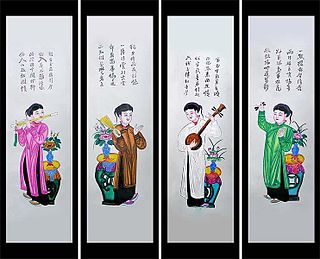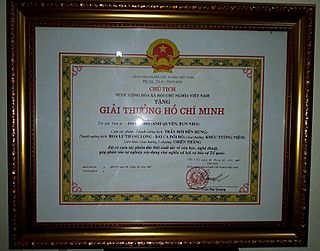Related Research Articles
Articles related to Vietnam and Vietnamese culture include:

Nguyễn Phú Trọng is a Vietnamese politician who has served as general secretary of the Communist Party of Vietnam since 2011. As the head of the party's Secretariat, Politburo and Central Military Commission, Trọng is Vietnam's paramount leader. He also previously served as president of Vietnam from 2018 to 2021.

Bùi Xuân Phái was a Vietnamese painter. He is famous for the painting of Hanoi Old Quarters. He also painted the actors and musicians of Vietnamese opera.

Vietnamese art is visual art that, whether ancient or modern, originated in or is practiced in Vietnam or by Vietnamese artists.

The Metropolitan Archdiocese of Saigon or Archidioecesis Hochiminhopolitana is a Roman Catholic ecclesiastical territory in the south of Vietnam. By far the largest diocese in the country by population of people and second in the number of Catholics, yet like most big cities it only covers a small area of 2,390 km2 (920 sq mi).
The Ministry of Industry and Trade is the government ministry in Vietnam responsible for the advancement, promotion, governance, regulation, management and growth of industry and trade. The former Ministry of Trade has its origins in 1945 with the formation of the modern National Unification Cabinet, and became a ministry in its own right in 1955. The Ministry of Trade merged with the Ministry of Industry in 2007 to form the Ministry of Industry and trade. The current Minister of Industry and Trade is Nguyễn Hồng Diên. Ministry main offices are located in Hanoi.
The 5th Vietnam Film Festival was held from May 12 to May 19, 1980, in Hanoi, Vietnam, with the slogan: "For the Socialist Fatherland and the people's happiness. For the development of the national cinema".
Thierry Bernard-Gotteland is a French artist. He lives and works among France and Vietnam.

The Hồ Chí Minh Prize is an honorary award given by the government of Vietnam in recognition of cultural and/or scientific achievement. The prize was established by decree in 1981, and has been awarded in 1996, 2000, 2005 and 2012, often posthumously. The prize is named for Ho Chi Minh, who was Chairman and founder of the Workers' Party of Vietnam, that is considered one of the highest honors bestowed by Vietnam.

Tô Ngọc Vân, also known as Tô Tử, was a Vietnamese painter. Several of his paintings are being displayed at the Vietnam National Museum of Fine Arts. He taught a resistance art class in the northern zone during the war with the French, and died as the result of injuries received at the Battle of Điện Biên Phủ. He was among the first recipients of the Ho Chi Minh Prize in 1996.

Phan Kế An, also known under the pseudonym Phan Kích, was a Vietnamese painter and renowned lacquer artist. He was the son of Phan Kế Toại (1892–1973) who was the personal envoy to Tonkin of the last Emperor of Vietnam, Bảo Đại, the Minister of Home Affairs (1945-1955) and former deputy prime minister of North Vietnam from 1955-1973.
Đỗ Thị Ninh is a Vietnamese woman painter, though she refuses to be labelled a "woman artist". She graduated from Hanoi's Vietnam College of Fine Arts in 1966. She is one of the generation of artists which emerged, aged then 45–55 in the early 1980s which included Đặng Thị Khuê, Đỗ Sơn, Lương Xuân Đoàn, Nguyễn Xuân Tiệp, Nguyễn Bảo Toàn in Hanoi, Nguyễn Trung, Đỗ Quang Em (1942–2021), Ca Lê Thắng, Đào Minh Tri, Nguyễn Thân in Ho Chi Minh City, Bửu Chi and Hoàng Đăng Nhuận in Huế.
Nha San Collective is the first and longest-running, non-profit, artist-run space for experimental art that was realized in the political scene in Vietnam. It has been a pioneer in facilitating an experimental art movement and in promoting contemporary culture.
The tradition of photography started in the 19th century in Vietnam and has since then given rise to modern photography and photojournalism into the 20th century.
Phạm Thanh Tâm was a Vietnamese journalist and war artist, who used the pen name Huỳnh Biếc. His career spanned the First Indochina War as a Việt Minh soldier participating in the resistance against French colonialism, as well as the Second Indochina War as a member of the People's Army of Vietnam against South Vietnam and the United States.
Thảo Nguyên Phan is a Vietnamese visual multimedia artist whose practice encompasses painting, filmmaking, and installation. She currently lives and works in Ho Chi Minh City and has exhibited widely in Vietnam and abroad. Drawing inspiration from both official and unofficial histories, Phan references her country's turbulent past while observing ambiguous issues in social convention, history, and tradition. She has exhibited in solo and group exhibitions in Vietnam and abroad, at many public institutions, including the Factory Contemporary Art Centre, Ho Chi Minh City; Nha San Collective, Hanoi; Rockbund Art Museum, Shanghai; Times Art Center in Berlin, Timișoara; and the Mistake Room, Los Angeles.
Witness Collection is one of the largest private collections of Vietnamese art in the world. It conducts detailed research into the art in its collection and Vietnam's 20th century history, as well as providing state-of-the-art conservation.

Lê Hiền Minh is a Vietnamese artist known for employing a Vietnamese traditional handmade paper called Dó to construct large-scale installations. Her work acts as a bridge between contemporary and traditional Vietnamese art and also between modern and historical Vietnamese culture. She currently lives and works in Ho Chi Minh City.

The 2nd Central Committee of the Workers' Party of Vietnam (WPV) was elected at the 2nd WPV National Congress. It elected the 2nd Politburo and the 2nd Secretariat.
References
- ↑ https://www.facebook.com/manhhungwind [ user-generated source ]
- ↑ https://www.facebook.com/manhhungwind [ user-generated source ]
- ↑ https://www.facebook.com/manhhungwind [ user-generated source ]
- ↑ https://www.facebook.com/manhhungwind [ user-generated source ]
- ↑ https://www.facebook.com/manhhungwind [ user-generated source ]
- ↑ https://www.facebook.com/manhhungwind [ user-generated source ]
- ↑ https://www.facebook.com/manhhungwind [ user-generated source ]
- ↑ "Art Vietnam Gallery: Artist Profile: Nguyen Manh Hung".
- ↑ "www.rorygillfineart.com | Wix.com". sintatantra.wix.com. Archived from the original on 26 January 2016.